To remove the metallic taste from your stainless steel water bottle, try using baking soda, lemon juice, vinegar, boiling water, citrus peels, and coffee grounds. These household items can help get rid of the unwanted flavor and leave your bottle fresh. Experiment with different methods like a vinegar soak or a citrus peel soak to find what works best for you. Remember to rinse thoroughly after using these solutions and consider trying saltwater rinse or cream of tartar paste for additional options. Your stainless steel water bottle will soon taste as good as new.
Use Baking Soda
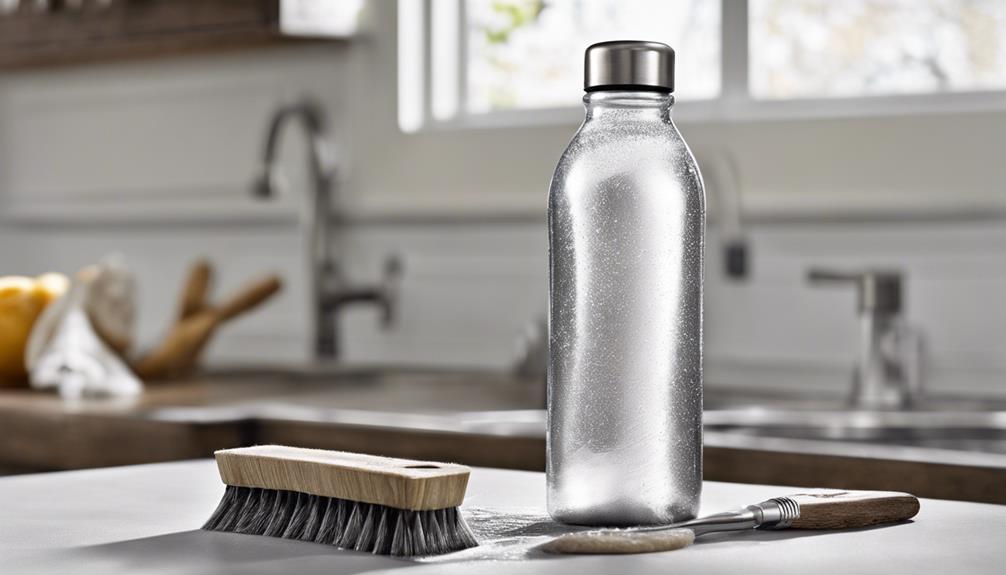
To effectively remove the metallic taste from your stainless steel water bottle, consider utilizing baking soda. Baking soda offers a natural and safe way to eliminate odors and tastes from your bottle without leaving any harmful residues. Its mild abrasive properties help scrub away any lingering flavors, leaving your bottle fresh and ready for use.
To use baking soda, create a paste by mixing it with water and then apply it to the interior of your water bottle. Let it sit for a few hours or overnight before rinsing thoroughly.
In addition to its odor-eliminating benefits, baking soda is also gentle on stainless steel, making it a suitable option for regular maintenance. It helps to remove stains, discoloration, and mineral deposits that may accumulate over time.
If you prefer alternatives to baking soda, consider using white vinegar or hydrogen peroxide, which also possess cleaning and deodorizing properties. Remember to rinse your water bottle well after using any cleaning agent to ensure no residue remains.
Regular care and maintenance will help keep your stainless steel water bottle in top condition for long-lasting use.
Lemon Juice Rinse
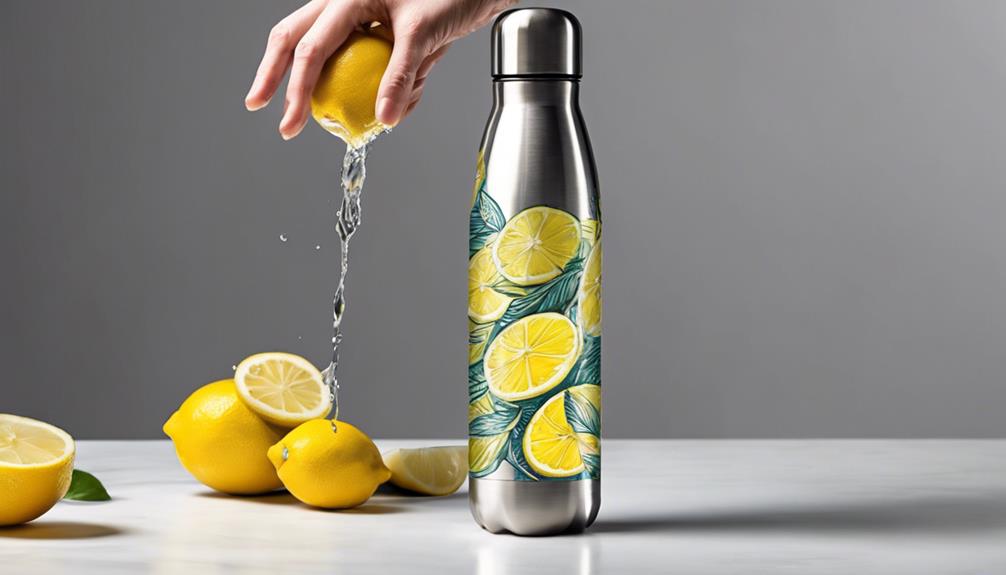
Consider incorporating a lemon juice rinse as a natural method to combat the metallic taste in your stainless steel water bottle. Lemon juice, a powerful natural alternative, offers various benefits in removing unwanted flavors from your bottle. The acidity of lemon juice helps break down the metallic residue that causes the unpleasant taste, effectively neutralizing it. Moreover, lemon juice is a safe and eco-friendly option compared to chemical-based alternatives.
The benefits of lemon juice extend beyond just removing the metallic taste. It also leaves a refreshing citrus scent that can mask any lingering odors in your bottle. Additionally, lemon juice has antibacterial properties that can help sanitize your bottle naturally. This dual-action of removing taste while providing a fresh scent and antibacterial benefits makes lemon juice a versatile and effective solution.
To use lemon juice for rinsing, simply squeeze fresh lemon juice into your bottle, add a bit of water, shake well, and let it sit for a few minutes before rinsing thoroughly. This straightforward method can help keep your stainless steel water bottle tasting fresh and clean.
Vinegar Soak
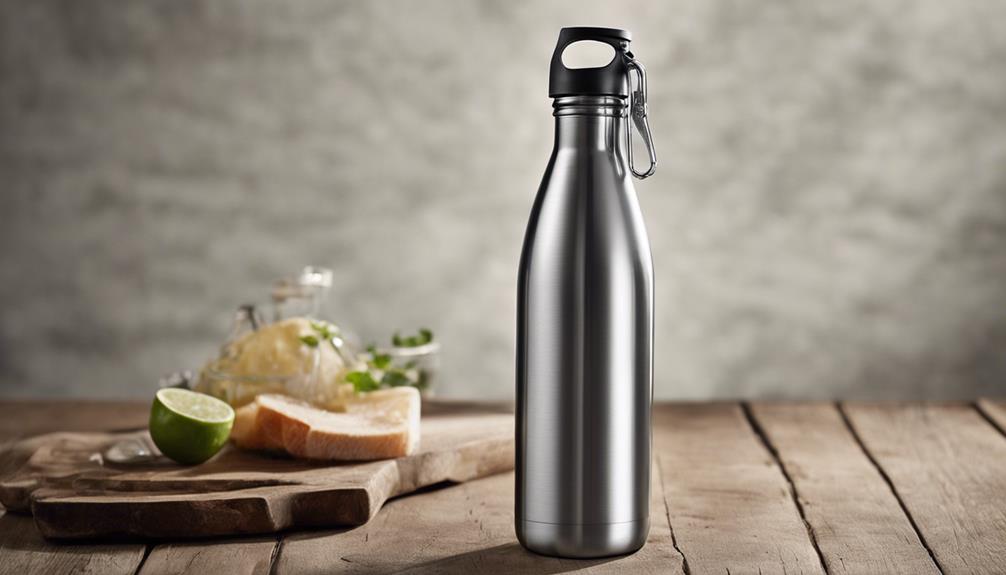
For a more intensive method to eliminate the metallic taste from your stainless steel water bottle, you can utilize a vinegar soak. Vinegar, specifically white vinegar, offers numerous benefits when it comes to cleaning and maintaining stainless steel items. Its acidic nature helps break down mineral deposits and residue that may be causing the metallic taste in your bottle. Additionally, vinegar is a safe and natural cleaner that is effective in removing odors and disinfecting surfaces, making it an ideal solution for refreshing your water bottle.
Here is a table summarizing the benefits of vinegar and its role in stainless steel maintenance:
| Vinegar Benefits | Stainless Steel Maintenance |
|---|---|
| Natural cleaner | Helps remove mineral deposits |
| Disinfectant | Eliminates odors |
| Safe to use | Breaks down residue |
| Cost-effective | Prevents bacterial growth |
| Eco-friendly | Maintains stainless steel shine |
Boiling Water Rinse
Boiling water can effectively help remove any lingering metallic taste from your stainless steel water bottle. The boiling method is known for its effectiveness in sanitizing and eliminating odors from containers.
When you boil water, the high temperature kills bacteria and other microbes that might be contributing to the metallic taste. Additionally, boiling water can help break down any residual compounds causing the unwanted flavor.
In terms of health benefits, boiling water is a simple way to ensure that the water you consume is free from harmful pathogens. The high temperatures reached during boiling make it a reliable method for water sterilization in situations where water quality is questionable.
While boiling water can improve the taste of your stainless steel water bottle, it's essential to note that minerals present in the water can affect its taste after boiling. Depending on the mineral content, boiled water may have a slightly different taste compared to water straight from the tap.
Citrus Peel Soak
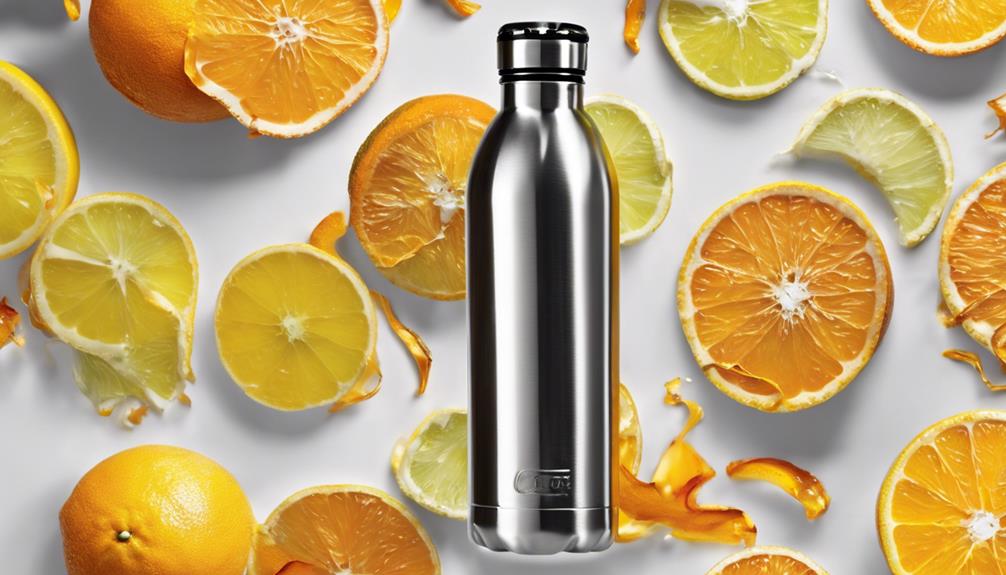
To effectively remove the metallic taste from your stainless steel water bottle, consider soaking citrus peels in the bottle. Citrus peels, such as lemon or orange, can help neutralize the metallic taste due to their acidity and natural oils. Here are some key points to consider:
- Citrus benefits: Citrus fruits are rich in antioxidants and Vitamin C, which can help promote overall health and boost your immune system.
- Alternative methods: If you don't have citrus peels on hand, you can also use citrus juice or slices to achieve a similar effect.
- Eco-friendly solutions: Using citrus peels is a sustainable and natural way to freshen up your water bottle without relying on harsh chemicals.
- Health benefits: Apart from improving the taste of your water, citrus peels can also aid in digestion and provide a refreshing flavor to your beverages.
Denture Tablets Soak
To effectively eliminate the metallic taste from your stainless steel water bottle, consider using the Denture Tablets Soak method.
This technique involves soaking your bottle in a solution of water and denture tablets, which can help remove the unwanted taste.
The process typically requires a specific amount of time for the tablets to work their magic and leave your bottle tasting fresh.
Denture Tablet Method
Consider using a denture tablet soak to effectively remove the metallic taste from your stainless steel water bottle. This method is simple and efficient, providing a convenient solution to improve the taste of your water bottle.
Here are some key points to consider:
- Denture tablet alternatives can include effervescent denture cleaning tablets or denture cleaning powders, which can also effectively eliminate the metallic taste.
- Natural cleaning methods like using baking soda or vinegar may be gentler alternatives for those looking for a chemical-free solution.
- Denture tablets typically contain ingredients like baking soda, citric acid, and other cleaning agents that work effectively to remove odors and tastes.
- This method is easy to use: simply fill your stainless steel water bottle with water, drop in the denture tablet, let it fizz and soak for the recommended time, then rinse thoroughly before use.
Soaking Process Details
Utilizing a denture tablet soak effectively eliminates the metallic taste from your stainless steel water bottle. The soaking process offers numerous benefits, such as effectively removing unpleasant tastes and odors that may affect the quality of your drinking water. Denture tablets are a convenient and cost-effective solution compared to other alternatives like vinegar or baking soda.
The duration of the soaking process can vary depending on the severity of the metallic taste. Generally, allowing the denture tablet to dissolve in water and then soaking your stainless steel bottle for a few hours or overnight can significantly improve the taste. The effectiveness of the soaking method has been widely reported by users who've successfully eliminated metallic tastes from their bottles.
While there are alternative methods available for removing metallic tastes, the denture tablet soak stands out for its simplicity and effectiveness. By following the recommended soaking duration, you can enjoy clean and fresh-tasting water from your stainless steel bottle.
Time Needed for Soaking
How long should you typically soak your stainless steel water bottle in a denture tablet solution to effectively remove the metallic taste?
The effectiveness of removing the metallic taste from your stainless steel water bottle can vary based on the duration of soaking. Here are some guidelines to help you decide on the optimal soaking time:
- Overnight soaking, effectiveness:
Soaking your stainless steel water bottle in a denture tablet solution overnight can be highly effective in removing the metallic taste. The extended duration allows the cleaning agents in the solution to thoroughly work on the metal surfaces, ensuring a more thorough cleansing.
- Quick soak, results comparison:
Alternatively, a quick soak of 30 minutes to an hour can also yield satisfactory results. While not as thorough as overnight soaking, a quick soak can still help reduce the metallic taste significantly, making your water bottle more pleasant to use.
Consider the level of metallic taste present in your bottle when deciding on the soaking duration.
Salt and Vinegar Scrub
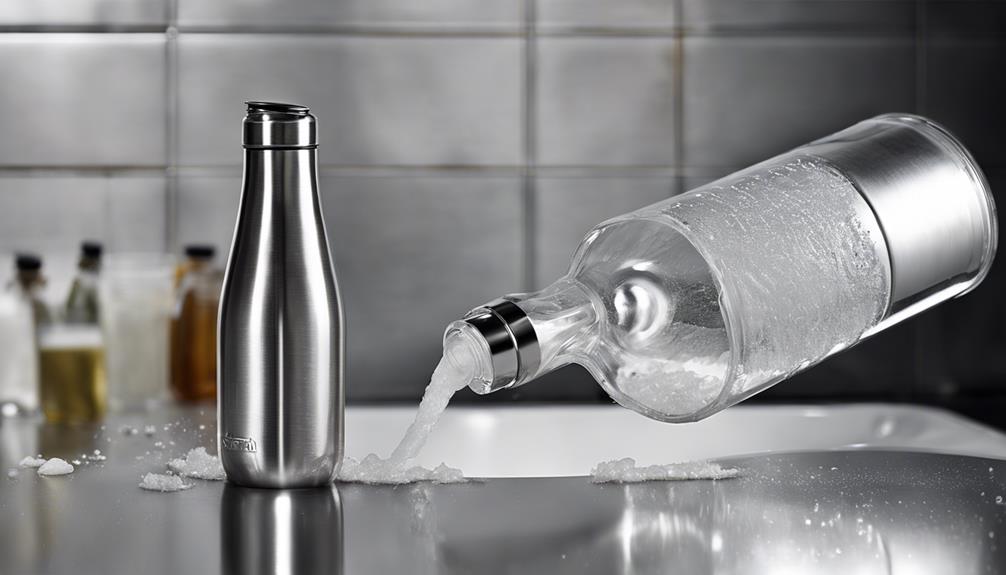
One effective method for removing the metallic taste from your stainless steel water bottle is by creating a salt and vinegar scrub. Vinegar, a common household item, offers acidity that helps break down the metallic residue in the bottle. Its acidic nature aids in removing impurities, leaving your bottle fresh and clean.
When creating the scrub, mix vinegar with salt to form a paste. Salt acts as an abrasive agent, aiding in scrubbing away the metallic taste effectively.
To use this scrub, apply the mixture to the interior of the bottle and scrub vigorously using a bottle brush or sponge. Ensure all areas are covered, especially focusing on spots where the metallic taste may be more concentrated. Allow the scrub to sit for a few minutes before rinsing thoroughly with warm water. Repeat the process if necessary until the metallic taste is fully eliminated.
This method provides a natural and efficient way to refresh your stainless steel water bottle.
Baking Powder Paste
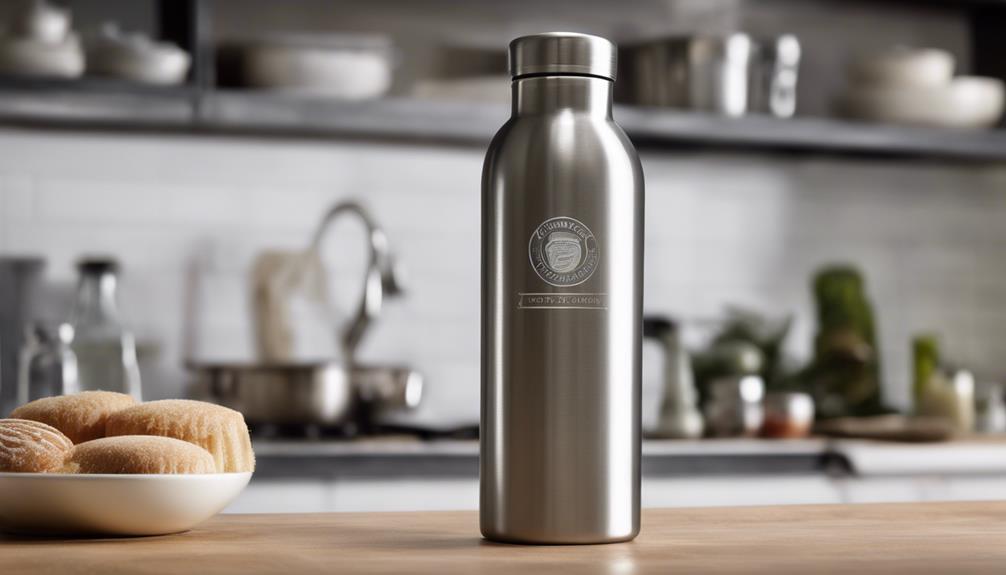
To remove the metallic taste from your stainless steel water bottle, consider using a baking powder paste.
This method involves applying the paste to the interior of the bottle, scrubbing it thoroughly to eliminate any lingering tastes, and rinsing the bottle thoroughly after.
Baking powder is known for its odor-neutralizing properties, making it a potentially effective solution for refreshing your water bottle.
Baking Powder Application
For removing a metallic taste from your stainless steel water bottle, creating a baking powder paste can be an effective solution. Baking powder offers benefits beyond just being a leavening agent in baking—it's mild abrasive properties make it ideal for cleaning and deodorizing purposes.
Here are some tips and tricks for using baking powder in this context:
- Neutralize Odors: Baking powder can help neutralize odors that may contribute to the metallic taste in your water bottle.
- Gentle Abrasive: Its gentle abrasive nature can help scrub away residue without damaging the stainless steel surface.
- Effervescent Action: When mixed into a paste with water, baking powder's effervescent action can aid in lifting stubborn tastes and stains.
- Safe and Natural: Unlike harsh chemical cleaners, baking powder is safe, natural, and environmentally friendly.
Scrubbing With Paste
To effectively remove the metallic taste from your stainless steel water bottle, creating a baking powder paste and scrubbing with it can help eliminate any lingering flavors and odors. This paste application method involves mixing baking powder with water to create a thick paste. The mild abrasive properties of baking powder can help in removing the metallic taste without damaging the stainless steel surface.
When scrubbing the interior of the bottle with the baking powder paste, ensure to cover all areas thoroughly. Focus on areas where the metallic taste seems to be more pronounced. You can use a soft-bristled brush or a sponge to gently scrub the paste around the interior of the bottle.
This technique is a part of stainless steel care tips to maintain the quality of your water bottle. It complements the vinegar scrubbing technique to ensure a thorough cleaning process.
Rinsing Thoroughly After
After scrubbing the stainless steel water bottle with the baking powder paste, ensure to rinse it thoroughly with warm water to remove any residue and leftover paste. This step is crucial to ensure that your water bottle is clean and free from any remaining cleaning solution.
Here are some important points to consider:
- Use a high-pressure stream of water: Rinse the bottle using a high-pressure stream of warm water to ensure all the baking powder paste is completely washed away.
- Inspect for residue: After rinsing, carefully inspect the bottle for any remaining residue or paste. If you notice any, rinse the bottle again until it's completely clean.
- Consider air-drying: Once you have thoroughly rinsed the bottle, consider air-drying it upside down on a drying rack to allow any remaining water to drip out.
- Environmental impact: Be mindful of the environmental impact of your water bottle cleaning routine. Opt for eco-friendly cleaning products and consider reusing water used for rinsing for other purposes to minimize water wastage.
Following these steps will help ensure your stainless steel water bottle is clean and ready for use.
Essential Oil Rinse
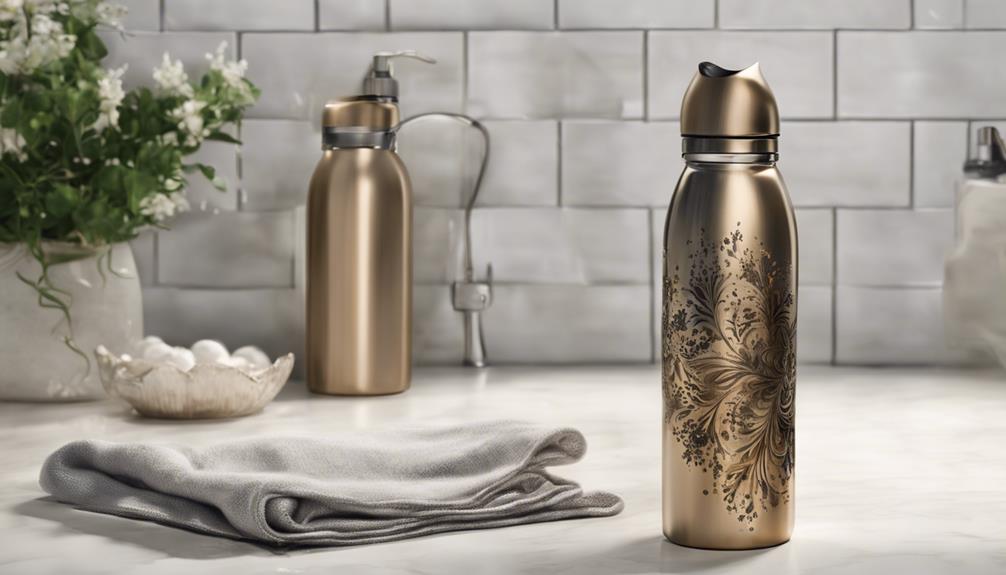
Consider incorporating a few drops of your preferred essential oil into warm water to create a natural rinse that can help eliminate the metallic taste from your stainless steel water bottle. Essential oils not only offer aromatherapy benefits but also aid in stainless steel care by providing a gentle yet effective cleaning method.
The antimicrobial properties of certain essential oils make them ideal for natural disinfection, contributing to eco-friendly cleaning practices. When choosing essential oils for your rinse, opt for ones with antibacterial and antifungal properties such as tea tree, lavender, or lemon. These oils not only combat the metallic taste but also leave a pleasant scent behind.
To prepare the rinse, simply add a few drops of the essential oil of your choice to warm water, swish the mixture around the bottle thoroughly, and then rinse it out with clean water. This method not only helps in removing the metallic taste but also contributes to maintaining the hygiene of your stainless steel water bottle.
Hydrogen Peroxide Soak
A hydrogen peroxide soak can effectively help in removing the metallic taste from your stainless steel water bottle.
Hydrogen peroxide's oxidizing properties make it a potent solution for breaking down and eliminating unwanted flavors and odors lingering in your bottle.
Here are some key points to consider when using hydrogen peroxide for this purpose:
- Hydrogen Peroxide Effectiveness: Hydrogen peroxide is known for its effectiveness in breaking down organic compounds, making it a suitable option for removing metallic tastes from stainless steel bottles.
- Alternative Methods: While hydrogen peroxide is effective, you can also consider using baking soda or vinegar solutions as alternative natural options for eliminating metallic tastes.
- Benefits of Hydrogen Peroxide Soaking: Apart from removing metallic tastes, hydrogen peroxide soaking can also help disinfect your bottle, ensuring it remains clean and safe to use.
- Stainless Steel Care Tips: Remember to thoroughly rinse your bottle after the hydrogen peroxide soak to ensure no residue is left behind. Additionally, dry your bottle completely to prevent water spots or potential bacterial growth, maintaining the quality of your stainless steel bottle.
Hot Water and Soap Wash
How can a hot water and soap wash effectively remove any lingering metallic taste from your stainless steel water bottle? A combination of hot water and soap can be a simple yet powerful method to ensure your bottle is clean and taste-free. By using a soft sponge scrub for gentle cleaning and a quick drying technique to prevent water spots, you can enhance the effectiveness of this cleaning method.
To illustrate the benefits of a hot water and soap wash, consider the following table:
| Cleaning Method | Effectiveness | Ease of Use |
|---|---|---|
| Hot Water and Soap | High | Easy |
| Hydrogen Peroxide Soak | Medium | Moderate |
| Coffee Grounds Soak | Low | Complex |
Coffee Grounds Soak
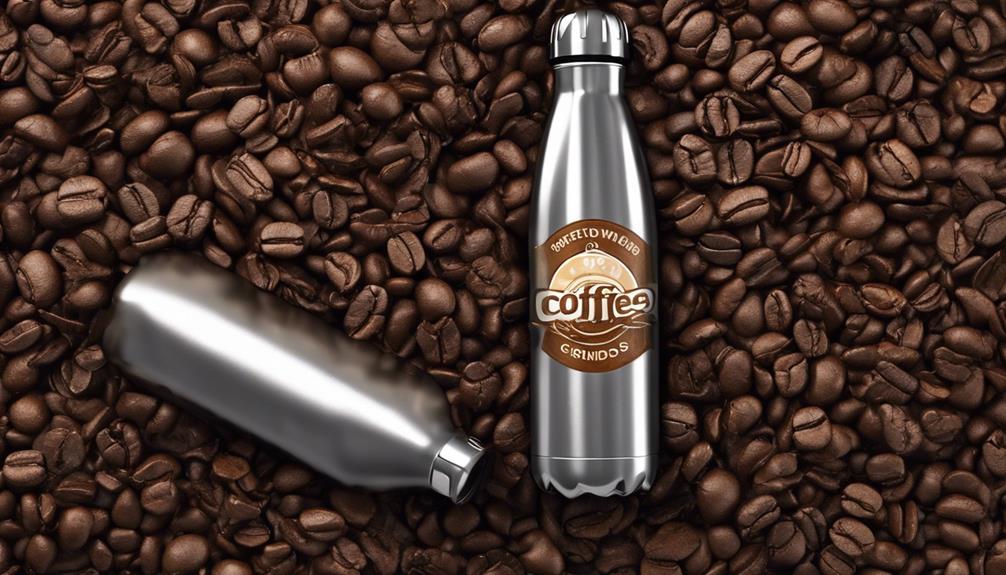
Enhance the removal of persistent metallic tastes from your stainless steel water bottle by utilizing a coffee grounds soak method. Coffee grounds offer various benefits beyond just making a delicious cup of coffee. When used as a soak for your stainless steel water bottle, they can help eliminate unwanted flavors and odors effectively.
Here are some tips to make the most of this method:
- Natural Absorbent: Coffee grounds act as a natural absorbent, trapping and neutralizing odors lingering in your water bottle.
- Exfoliating Properties: The texture of coffee grounds can help scrub away residue and stains, leaving your bottle cleaner and fresher.
- Environmentally Friendly: Using coffee grounds for cleaning is eco-friendly and sustainable, reducing the need for harsh chemicals.
- Cost-Effective Solution: Repurposing coffee grounds for cleaning your water bottle is a budget-friendly approach to stainless steel maintenance.
Alka-Seltzer Solution Rinse
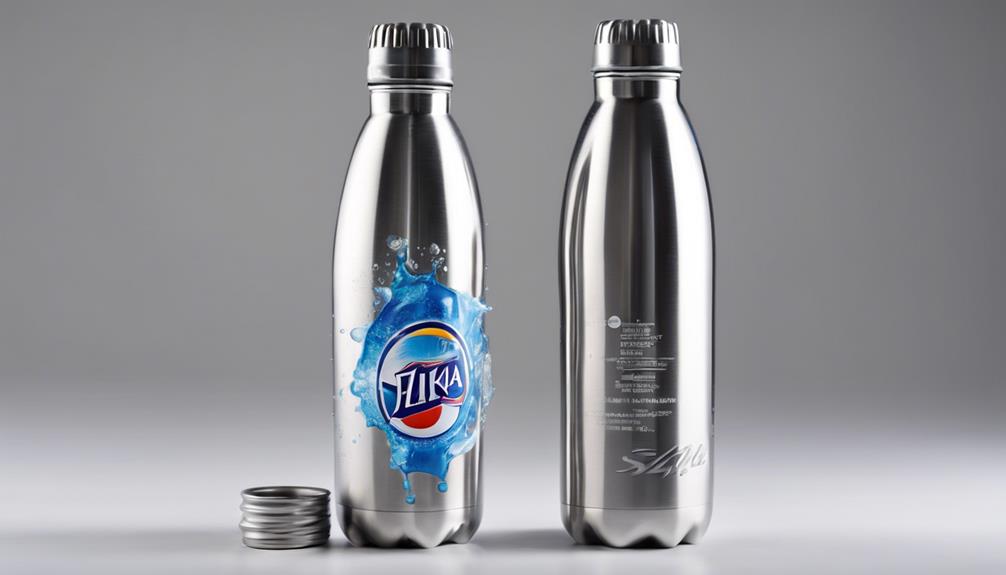
To further address any lingering metallic taste in your stainless steel water bottle, consider utilizing an Alka-Seltzer solution rinse. Alka-Seltzer tablets contain citric acid and baking soda, which create an effervescent reaction when dissolved in water. This bubbling action helps to clean and refresh the interior of your bottle, leaving a fizzy fresh finish that can eliminate any residual metallic taste.
To perform the Alka-Seltzer solution rinse, fill your stainless steel water bottle with warm water and drop in a couple of Alka-Seltzer tablets. Allow the tablets to dissolve completely, creating a bubbly solution rinse. Swirl the solution around, ensuring it comes into contact with all interior surfaces of the bottle. Let it sit for a few minutes to maximize the cleaning effect of the bubble bath method. Finally, rinse the bottle thoroughly with water to remove any remaining solution.
This effervescent clean method is a quick and easy way to freshen up your stainless steel water bottle and get rid of any unwanted metallic taste.
Saltwater Rinse
Consider utilizing a saltwater rinse as a simple and effective method to remove any lingering metallic taste from your stainless steel water bottle. Saltwater offers benefits such as being a natural disinfectant and deodorizer, making it an ideal choice for cleaning your bottle.
However, there are some drawbacks to be mindful of, such as the potential for salt residue if not rinsed thoroughly. Here are some key points to consider:
- Benefits of Saltwater Rinse:
- Natural disinfectant properties
- Effective deodorizer
- Simple and readily available solution
- Drawbacks of Saltwater Rinse:
- Potential for salt residue if not rinsed properly
When considering alternative rinse methods, some options to explore include using baking soda solution, lemon juice rinse, or white vinegar soak. These alternatives can also help in neutralizing odors and removing any metallic taste from your stainless steel water bottle.
Cream of Tartar Paste
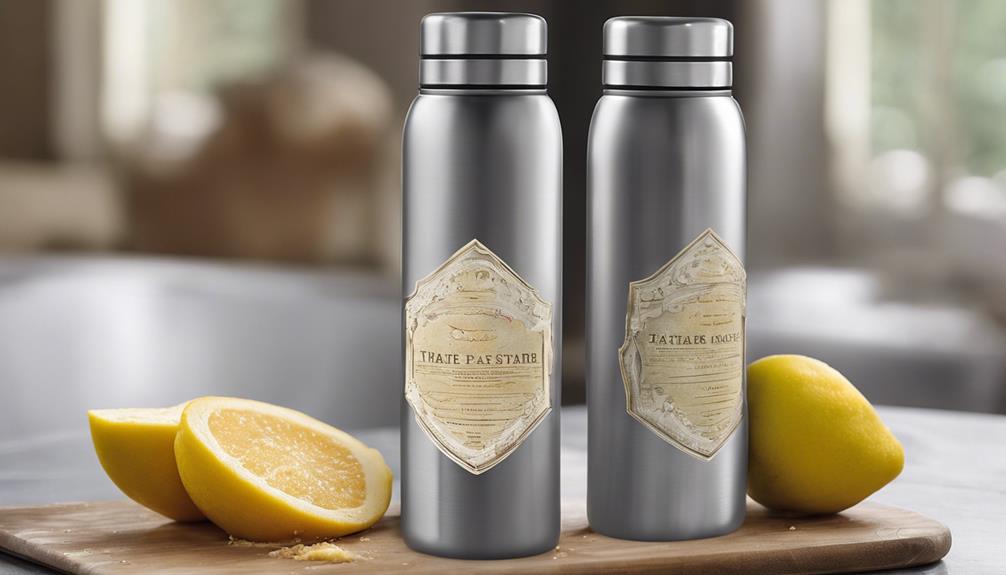
Using a small amount of cream of tartar to create a paste can be an effective method for eliminating metallic taste from your stainless steel water bottle. Cream of tartar, a byproduct of winemaking, has several benefits beyond its culinary uses.
When mixed with a small amount of water to form a paste, cream of tartar can act as a natural remedy for neutralizing and removing the metallic taste that may develop in stainless steel water bottles over time.
The benefits of cream of tartar in this homemade paste lie in its acidic properties, which can help break down and loosen the metallic residues causing the unwanted taste in your water bottle.
By applying the cream of tartar paste to the interior of the bottle and allowing it to sit for a short period before rinsing thoroughly, you can effectively combat the metallic taste without the need for harsh chemicals or strong odors.
This simple and natural solution offers a safe and cost-effective way to refresh your stainless steel water bottle and enhance your drinking experience.
Frequently Asked Questions
Can I Use Dish Soap to Clean the Metallic Taste From My Stainless Steel Water Bottle?
You can use a vinegar solution, baking soda paste, lemon juice, or boiling water to eliminate a metallic taste from your stainless steel water bottle. Avoid using dish soap as it may not be as effective.
Is It Safe to Use Abrasive Scrubbers on Stainless Steel Water Bottles?
You wouldn't use a sledgehammer for delicate work. Similarly, avoid abrasive scrubbers on stainless steel bottles to prevent scratches. Opt for alternative cleaning methods like using baking soda or vinegar to maintain the bottle's integrity.
How Often Should I Clean My Stainless Steel Water Bottle to Remove Metallic Taste?
To eliminate metallic taste from your stainless steel water bottle, ensure proper maintenance by cleaning it regularly. Cleaning frequency varies but aim for at least once a week. This practice will help keep your water tasting fresh and clean.
Can I Use a Dishwasher to Clean My Stainless Steel Water Bottle?
Using a dishwasher for your stainless steel water bottle can be convenient, but remember to check dishwasher safety guidelines. While it's generally safe, hand washing ensures cleaning effectiveness and longevity for your bottle.
Will the Metallic Taste Return After Using These Methods to Remove It?
If your taste buds are sensitive, even after removing the metallic taste, it may return due to the water's quality. Consider using a filtration system to ensure the water you use doesn't reintroduce the unwanted flavor.
Conclusion
In conclusion, there are numerous effective methods to eliminate the metallic taste from a stainless steel water bottle. By following the recommended steps such as using baking soda, lemon juice, vinegar, boiling water, citrus peel, coffee grounds, Alka-Seltzer, saltwater, or cream of tartar, you can easily restore the freshness of your bottle.
So, don't let that unwanted taste linger any longer - try these simple solutions and enjoy your drinks without any unpleasant metallic aftertaste.

